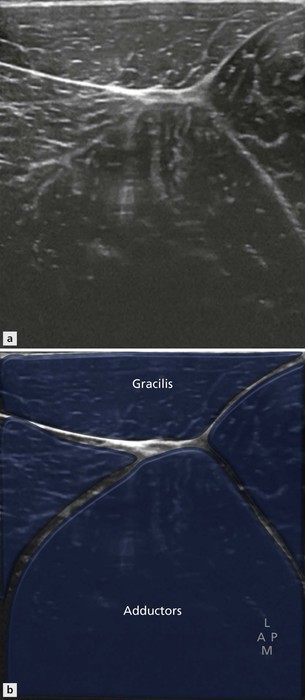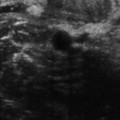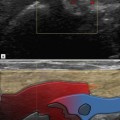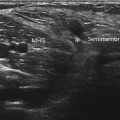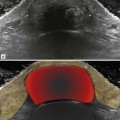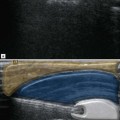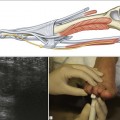Hip Joint and Thigh
Anatomy and Techniques
Introduction
Position 1: Adductor Insertion
Technique
The probe is placed on the anteromedial aspect of the thigh, first in the short axis of the adductor longus, and then rotated into its long axis. The probe is moved superiorly until the rounded upper border of the adductor muscles gives way to a low-reflective triangular shaped tendon (Figs 16.1 and 16.2). This is the common adductor tendon that is attached to the pubis. The probe should be adjusted until it is, as far as is possible, perpendicular to the tendon in order to best visualize it. From this location, medial movement of the probe brings it to overlie the pubic symphysis, which is recognized as a low-signal space between the two pubic bones. More laterally, the adductor muscle origin from the inferior pubic ramus is seen.
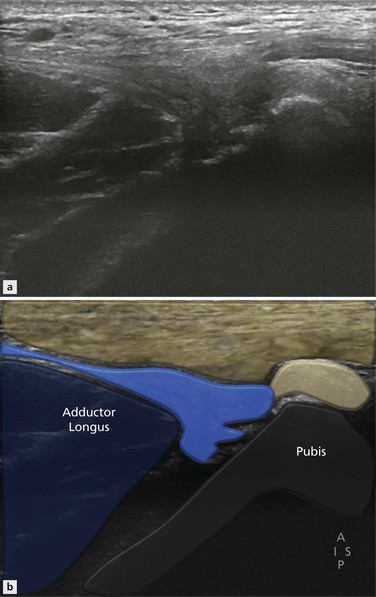
Figure 16.1 Adductor insertion in long axis. Note the low signal triangular shape of the common tendon. Some bony enthesopathy is present (this is not always symptomatic). Gentle pressure with the probe can provide clinical correlation.
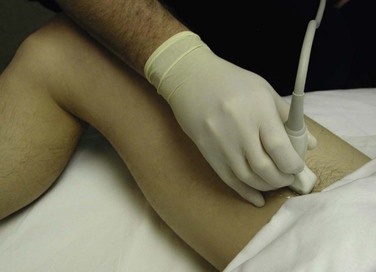
Figure 16.2 Frog-leg position for identifying the common adductor tendon. In this position, the palpable muscle is adductor longus. The probe can be placed lengthways along this muscle and then moved proximally until the triangular-shaped tendon appears.
Abnormal findings can be correlated with the patient’s symptoms with gentle sonopalpation.
From the common tendon insertion, the probe is moved distally until the three adductor muscles are found. From anterior to posterior they are: adductor longus, brevis and magnus. The common adductor tendon has usually split by this point, the larger anterior component being the tendon of adductor longus. Just behind this, the smaller component opens into a fourth muscle that overlies the adductors, the gracilis muscle (Fig. 16.3).
Position 2: Anterior Hip Joint
Technique
Returning to the level of the adductor tendon, the axially positioned probe is moved laterally along the superior pubic ramus. Pectineus is the muscle that separates the probe from the underlying pubic bone. Further lateral movement reveals the anterior acetabular wall, anterior labrum and rounded contour of the femoral head (Fig. 16.4). A small quantity of fluid may be detected in the hip joint. The psoas muscle/tendon lies lateral to pectineus, with the fleshy iliacus component distinguishable from the tendinous psoas portion. A little more distally the vastus intermedius appears in this position.
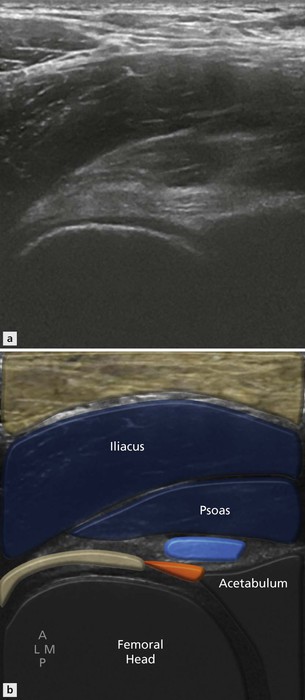
Figure 16.4 Hip joint axial image. The rounded contour of the femoral head provides an easily located landmark.
Iliopsoas snap can be elicited by abducting, flexing and externally rotating the hip and then bringing it back to the normal neutral position.
This is discussed more fully in the anterior hip pathology section on page 194.
Returning to pectineus, the probe can be moved a little distally to just below superior pubic ramus. Once the bone falls away from view, a neurovascular bundle is identified just beneath pectineus, surrounded by a small cuff fat (Fig. 16.5). This is the obturator nerve and artery. It is easy to find in thin people, but becomes rather deep and difficult to locate with enlarging body habitus. Moving the probe further distally still, the upper part of the adductor longus is seen with the other adductor muscles and the obturator externus below. If the probe is moved a little laterally, the bony contour of the femur is found and can be tracked distally until the lesser trochanter is visualized. This is a good position to identify the insertion of the iliopsoas tendon; some rotation of the probe is required to orientate the tendon in long axis.
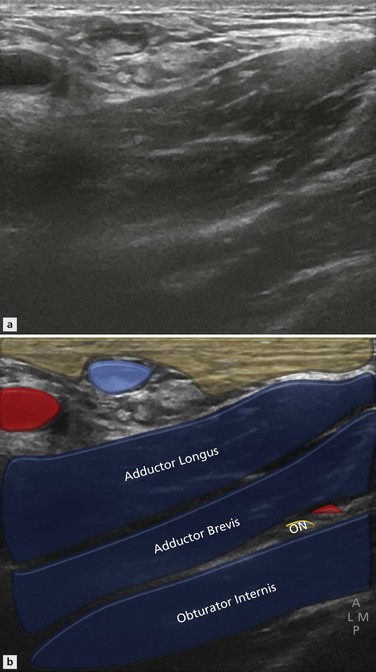
Figure 16.5 Axial image medial to the hip joint below, the superior pubic ramus. The obturator nerve can be located as it emerges from the obturator foramen.
On the anterior aspect of the hip, the anterosuperior labrum, anterior capsule and femoral head articular cartilage are noted.

